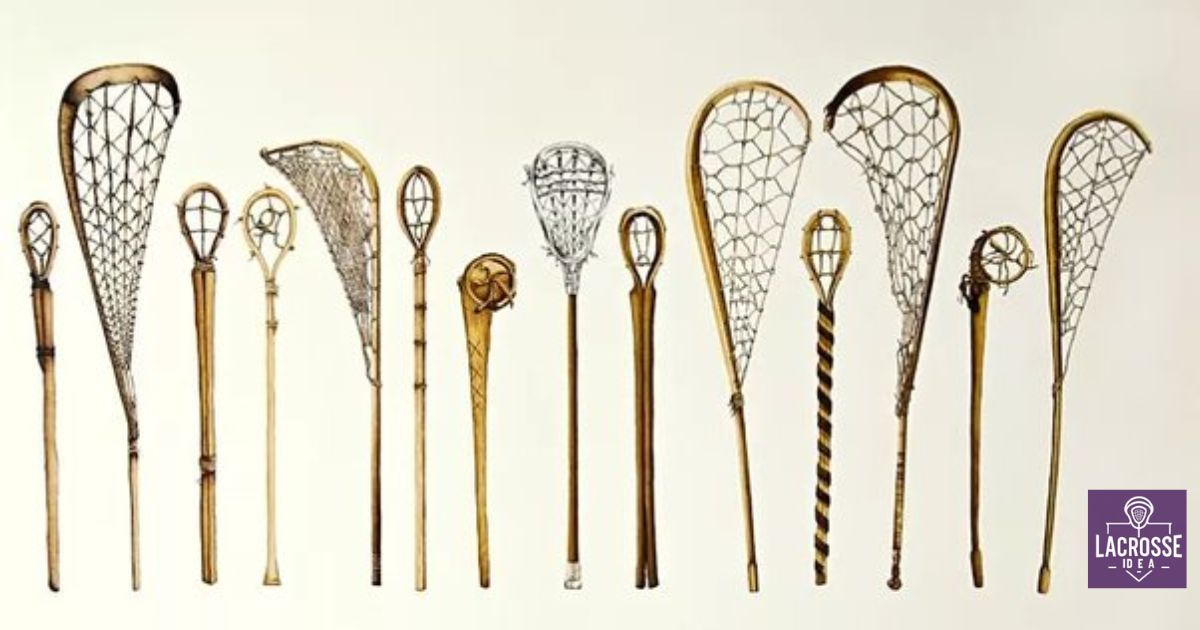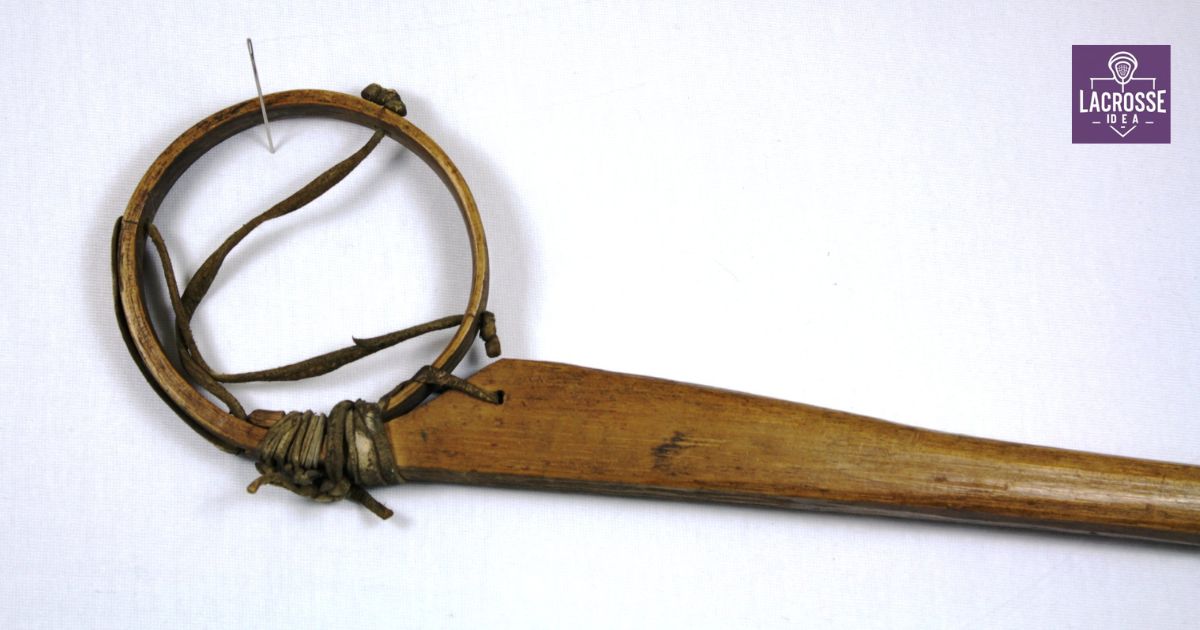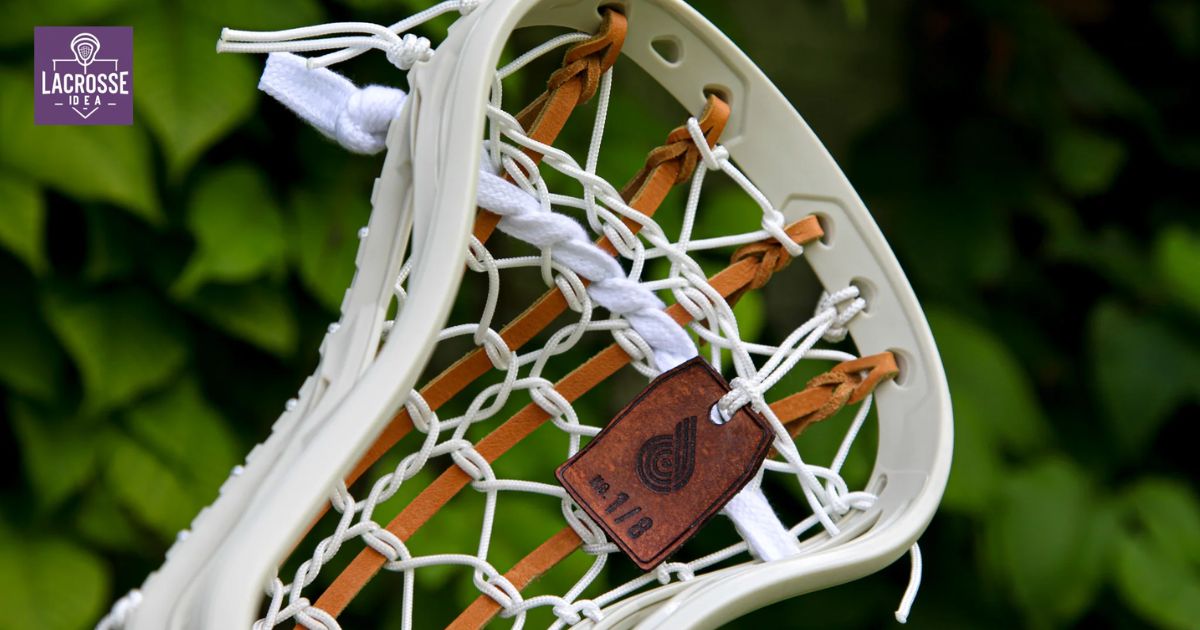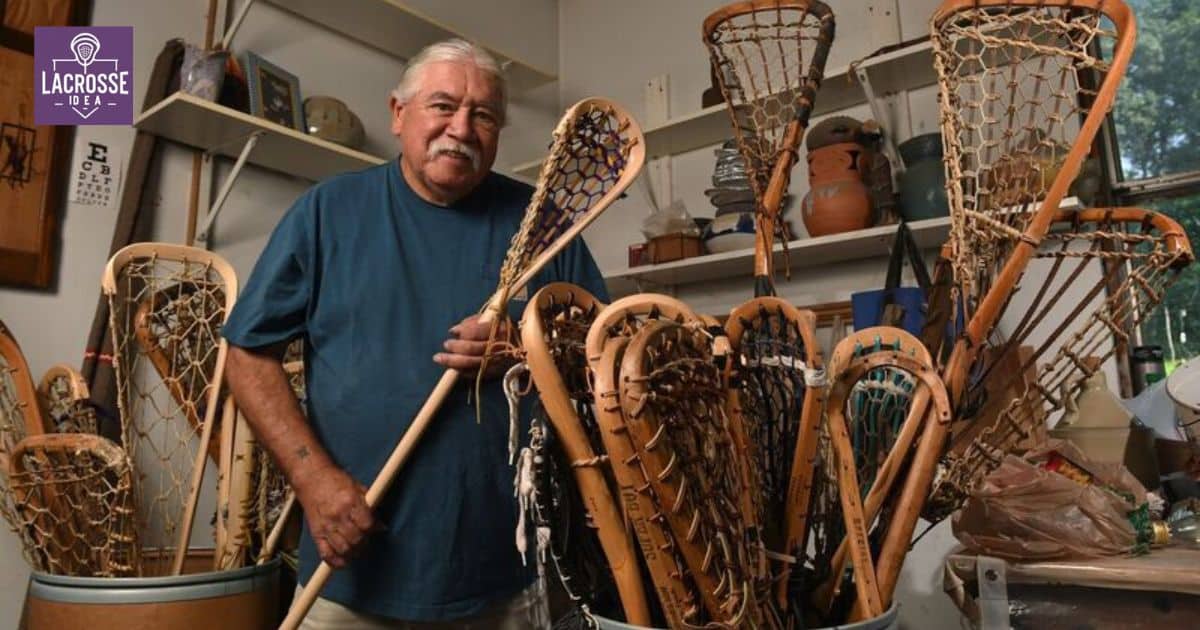In the rich tapestry of lacrosse, one element weaves a common thread: the stick. Like a skilled weaver, this essential tool intertwines the history, tradition, and innovation of the game. From the traditional sticks of yesteryear to the modern marvels gracing the hands of today’s athletes, the lacrosse stick is a symbol of unity and belonging in this ancient sport.
A lacrosse stick, sometimes known as a crosse, is used in the game. There are two components to it: the head and the shaft. The portion of the stick that grasps and retains the ball is called the head, while the portion that is extended and held in your hand is called the shaft. Join us as we explore the depths of its craftsmanship, its parts, and the long part of the stick aptly named the shaft.
Key Takeaways
- Lacrosse sticks have evolved over time, starting with ancient Native American cultures using natural materials and incorporating modern materials as the game gained popularity.
- There are different types of lacrosse sticks, including traditional sticks crafted by Native Americans and women’s modern sticks designed specifically for the women’s game.
- The essential parts of a lacrosse stick include the head, pocket, shaft, and butt end, each serving a specific function in catching, passing, and ball control.
- The lacrosse stick shaft can vary in length, flexibility, material, grip, and shape, all of which can affect a player’s reach, power, and control.
History Of Lacrosse Sticks
The evolution of lacrosse sticks can be traced back to ancient Native American cultures. Lacrosse, originally known as “stickball,” was played by various tribes across North America. These tribes crafted their sticks using natural materials such as wood, animal sinew, and leather. The sticks were meticulously designed to allow for precise ball control and accurate passing. The early sticks were often handmade and personalized, with unique designs and carvings that represented the player’s tribe or individual identity.
As the game of lacrosse gained popularity among European settlers, the design of the sticks began to incorporate modern materials such as metal and synthetic materials. Today, lacrosse sticks are highly specialized equipment, with different types and designs for different positions and playing styles. The history of lacrosse sticks serves as a testament to the rich cultural heritage and enduring legacy of the sport.
Traditional Stick
Crafted by ancient Native American cultures, the traditional lacrosse stick was meticulously designed using natural materials for precise ball control and accurate passing. These sticks were not only tools for playing the game but also held deep cultural significance. Made from hickory or ash wood, the traditional stick featured a long, curved handle with a woven net at the end. The netting was typically made from animal sinew or rawhide, creating a pocket that cradled the ball securely.
The design allowed players to scoop, catch, and throw the ball with great accuracy. The traditional stick represented the connection between the player and the game, embodying the spirit of lacrosse and the values of the Native American culture. Today, while modern sticks have evolved, the traditional stick remains an important symbol of the sport’s rich history and heritage.
Women’s Modern Stick
A popular choice for women players, the modern stick in lacrosse offers enhanced performance and versatility. Designed specifically for the women’s game, these sticks are lighter and have a shallower pocket than their male counterparts. Here are some key features of women’s modern lacrosse sticks:
- Improved materials: Modern sticks are constructed using advanced materials like carbon fiber and titanium, making them lighter and more durable.
- Enhanced pocket design: The pocket of a women’s stick is shallower, allowing for better ball control and accuracy during passes and shots.
- Flexible shaft options: Women’s sticks come in various shaft flexibilities, allowing players to choose one that suits their playing style and preference.
- Customization options: Players can personalize their sticks with different colors, patterns, and graphics, adding a touch of individuality to their gear.
Understanding the components of a women’s modern stick is crucial for mastering the game and optimizing performance. Now let’s delve into the various parts of a lacrosse stick.
Lacrosse Stick Parts
Constructed using various components, a lacrosse stick is comprised of several essential parts that contribute to its functionality and performance. The main components of a lacrosse stick include the head, pocket, shaft, and butt end. The head is the top part of the stick and is responsible for catching, passing, and shooting the ball. It consists of the scoop, sidewalls, and throat.
The pocket is the netting attached to the head, which holds the ball. The shaft is the long handle of the stick and provides stability and control. Lastly, the butt end is the bottom part of the stick, which players hold onto during the game. Each part plays a crucial role in the overall performance of the lacrosse stick, enabling players to effectively maneuver the ball and participate in the game with confidence and skill.
What Is The Long Part Of A Lacrosse Stick Called?
Continuing the discussion from the previous subtopic, the long part of a lacrosse stick is commonly referred to as the shaft. The shaft plays a crucial role in the overall functionality and performance of the stick. Here are four important aspects to consider regarding the lacrosse stick shaft:
- Material: The shaft can be made of various materials such as aluminum, titanium, composite, or wood. Each material offers distinct advantages in terms of durability, weight, and flexibility.
- Length: The length of the shaft is typically regulated by lacrosse governing bodies, with different specifications for players of different positions. Attackers and midfielders usually prefer shorter shafts for better control, while defenders and goalies generally opt for longer shafts to maximize reach.
- Grip: The shaft often features a grip that helps players maintain control during intense gameplay. Different grips, such as rubberized or textured surfaces, offer varying levels of comfort and traction.
- Design: The shaft may also incorporate unique designs, colors, or branding, allowing players to express their personal style and team spirit.
Understanding these aspects of the lacrosse stick shaft allows players to make informed choices based on their playing style and preferences.
What Is The Net Part Of A Lacrosse Stick Called?
The net part of a lacrosse stick is known as the head. It is an essential component of the stick, as it is used to catch, carry, and throw the ball. The head of a lacrosse stick consists of a frame and a mesh pocket. The frame provides the structure and stability, while the mesh pocket is where the ball is held. The mesh is typically made of nylon or synthetic materials, which are durable and weather-resistant.
The size and shape of the head can vary depending on the player’s position and personal preference. Attack and midfield players often prefer narrower heads for increased accuracy, while defense players opt for wider heads for better ball control and blocking. The table below summarizes the different types of lacrosse heads and their characteristics:
| Head Type | Characteristics |
|---|---|
| Universal | Versatile for all positions, offers a balance of ball control and accuracy |
| Attack | Narrower head for increased accuracy and quick ball release |
| Defense | Wider head for better ball control and blocking |
Understanding the different types of lacrosse heads can help players choose the one that suits their playing style and position, promoting a sense of belonging within the lacrosse community.
What Is The Stick Part Of A Lacrosse Stick Called?
The stick part of a lacrosse stick is referred to as the shaft. It is a long, cylindrical component that connects the head of the stick to the handle. The shaft is an essential element that provides players with control, stability, and balance during gameplay. Here are four key features of the lacrosse stick shaft:
- Material: Shafts can be made from a variety of materials, including aluminum, titanium, composite blends, or wood.
- Grip: The shaft may have different grip options, such as rubberized coatings or textured patterns, to enhance players’ hold and control.
- Length: The length of the shaft varies based on player preference, position, and playing style. Attackers and midfielders typically prefer shorter shafts for maneuverability, while defenders prefer longer shafts for increased reach and leverage.
- Flexibility: Some shafts have varying degrees of flexibility, allowing players to generate additional power and accuracy when shooting or passing.
Understanding the different features of the lacrosse stick shaft is crucial for players to select the right equipment that suits their playing style and position. Now, let’s move on to the next component of the lacrosse stick, the lacrosse head.
Lacrosse Head
Moving on to the next component of the lacrosse stick, let’s delve into the intricacies of the lacrosse head. The lacrosse head is the top part of the stick that holds the mesh or pocket where the ball is cradled and released. It plays a crucial role in controlling the ball and executing accurate passes and shots.
The design and features of the lacrosse head can vary, offering players different advantages based on their position and playing style. To give you a better understanding, here is a table outlining some key aspects of a lacrosse head:
| Aspect | Description |
|---|---|
| Scoop | The curved part of the head used for picking up ground balls. |
| Sidewall | The vertical side of the head that provides stability and strength. |
| Throat | The area where the head attaches to the shaft. |
| Offset | The angle at which the head is bent, affecting ball control and release. |
| The mesh or strings that hold the ball in the head. |
Now that we have explored the lacrosse head, let’s move on to the next component – lacrosse shafts.
Lacrosse Shafts
Continuing our exploration of lacrosse stick components, let’s now turn our attention to lacrosse shafts. These long, tubular pieces are an essential part of the stick and come in various materials and designs. Here are four key aspects to consider when it comes to lacrosse shafts:
- Material: Lacrosse shafts can be made of aluminum, titanium, composite materials, or wood. Each material offers different levels of strength, durability, and weight.
- Length: The length of the shaft is crucial as it affects the player’s reach, control, and maneuverability. The standard length for men’s lacrosse shafts is between 40 and 42 inches, while women’s lacrosse shafts are typically shorter.
- Shape: Lacrosse shafts can have different shapes, including octagonal, concave, or traditional round. The shape affects the player’s grip and feel of the stick.
- Grip: Many lacrosse shafts feature specialized grip technology, such as rubberized coatings or textured surfaces, to provide players with better control and handling.
Understanding these aspects of lacrosse shafts can help players find the perfect fit for their playing style and preferences, contributing to a more enjoyable and effective game experience.
Lacrosse Mesh
One important element of the lacrosse stick is the type of mesh used. Lacrosse mesh refers to the netting that is strung onto the head of the stick. The mesh plays a crucial role in controlling the ball and enhancing a player’s performance on the field. It provides the necessary grip and pocket formation to catch, cradle, and release the ball accurately and smoothly. The type of mesh used can vary, with options such as traditional hard mesh, soft mesh, or mesh with different patterns and weaves.
Each type of mesh offers different benefits, allowing players to customize their stick to suit their playing style and preferences. Understanding the different types of mesh and their characteristics is essential in selecting the right one for optimal performance. Now let’s delve into lacrosse stick guides to further explore the components of this versatile sporting equipment.
Lacrosse Stick Guides
To further understand the lacrosse stick and its components, let’s now explore the essential guides that assist players in selecting the perfect stick for their game. Here are some key factors to consider when choosing a lacrosse stick:
- Length: The length of the stick can affect your performance on the field. Attack and midfield players generally prefer shorter sticks for better maneuverability, while defensemen opt for longer sticks for increased reach and defensive capabilities.
- Weight: The weight of the stick is crucial for maintaining control and agility during gameplay. Lighter sticks are favored by offensive players, while heavier sticks provide more power and stability for defensive players.
- Flexibility: The flexibility of the stick determines its ability to handle shots and passes. Sticks with more flex are ideal for players who rely on quick releases and accuracy, while stiffer sticks offer more power and control.
- Pocket Depth: The depth of the stick’s pocket affects ball control and accuracy. A deeper pocket provides better ball retention, while a shallower pocket allows for quicker releases.
Lacrosse Stick Making In Akwesasne
The process of crafting lacrosse sticks in Akwesasne involves skillful artisans using traditional techniques and materials. These artisans possess a deep understanding of the cultural significance of lacrosse in their community, and their craftsmanship reflects this reverence. Each step of the process is carried out with meticulous care and attention to detail, ensuring that the final product is of the highest quality.
The artisans start by carefully selecting the right type of wood, usually hickory or ash, which is then shaped and bent into the desired form. The sticks are then meticulously strung with leather or synthetic mesh, creating the perfect pocket for catching and cradling the ball. The result is a lacrosse stick that not only performs exceptionally but also embodies the rich heritage and traditions of the Akwesasne community.
Frequently Asked Questions
How Long Has the Lacrosse Stick Been Used in the Game of Lacrosse?
The use of lacrosse sticks in the game of lacrosse has been documented for centuries. It is a crucial tool for players to handle and shoot the ball, allowing for precise control and strategic gameplay.
What Are the Main Differences Between the Traditional Stick and the Modern Stick Used in Women’s Lacrosse?
The main differences between the traditional and modern sticks used in women’s lacrosse lie in their construction and design. Traditional sticks were typically made from wood and had a deeper pocket, while modern sticks are made from composite materials and have a shallower pocket.
What Materials Are Commonly Used to Make Lacrosse Heads?
Common materials used in the construction of lacrosse heads include nylon, plastic, and mesh. These materials provide durability, flexibility, and control for players during the game.
How Do the Different Lacrosse Shafts Affect the Performance of the Stick?
The performance of a lacrosse stick can be influenced by various factors, including the type of shaft used. Different shaft materials, such as carbon fiber or alloy, can affect attributes like weight, durability, and flexibility, ultimately impacting player performance on the field.
Are There Any Specific Guidelines or Regulations for Using Lacrosse Sticks in Official Games?
Yes, there are specific guidelines and regulations for using lacrosse sticks in official games. These rules ensure fair play, safety, and uniformity in equipment. Compliance with these regulations is essential for participating in sanctioned lacrosse competitions.
Conclusion
In conclusion, lacrosse sticks have evolved over time, with traditional and modern variations for different genders. The long part of a lacrosse stick is called the shaft, which is an essential component. Another important part is the lacrosse mesh, which is used for catching and throwing the ball. Lacrosse stick making in Akwesasne showcases traditional craftsmanship and cultural significance. It is interesting to note that lacrosse is the fastest-growing sport in North America, with over 825,000 participants as of 2020.









